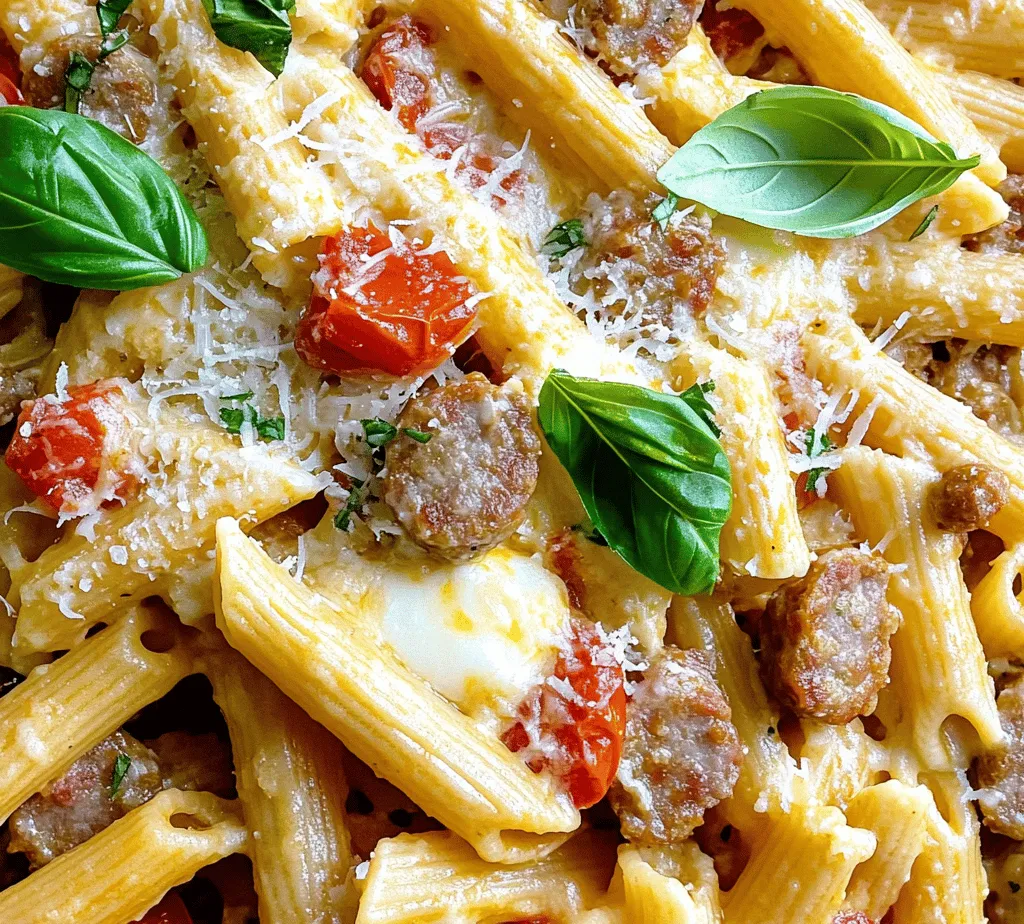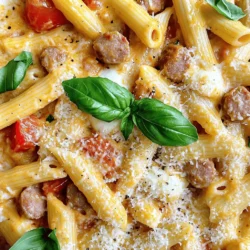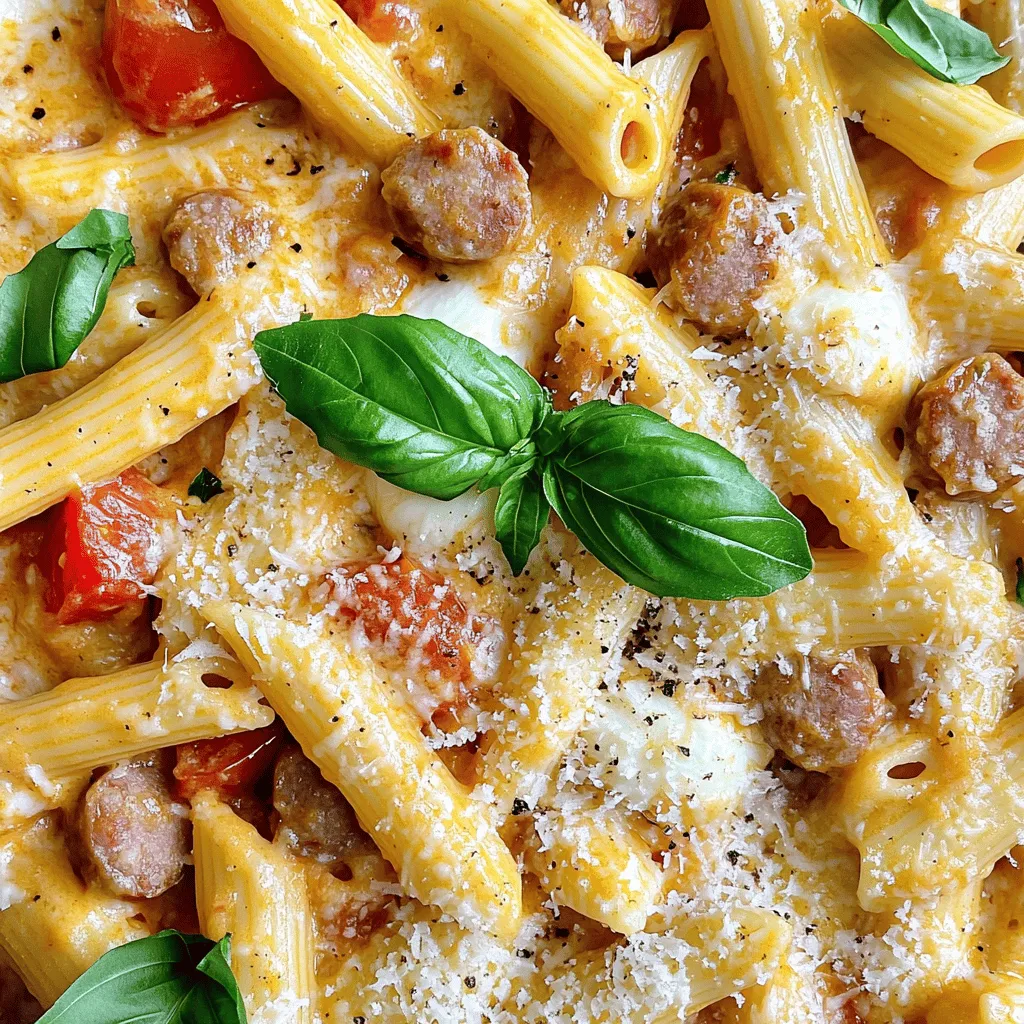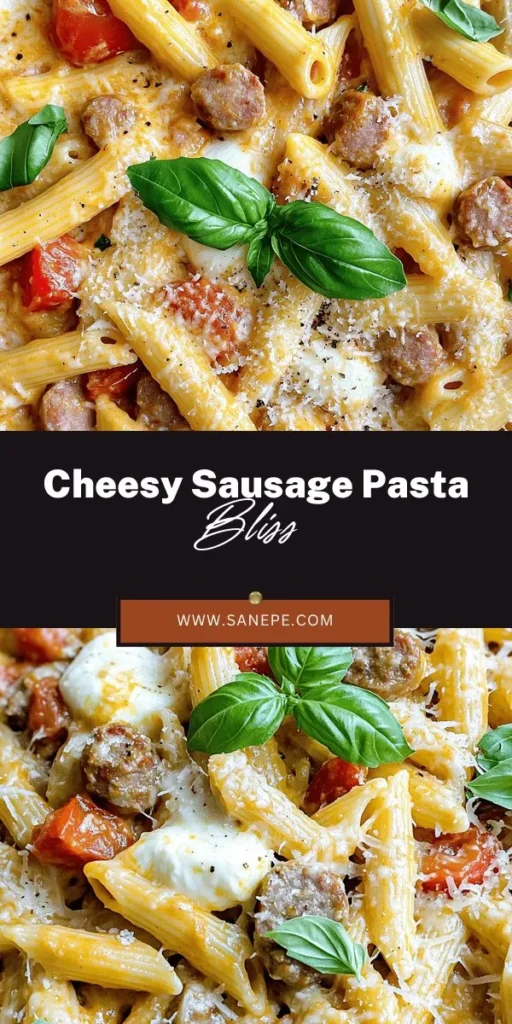Introduction
Cheesy Sausage Pasta is a delicious, hearty dish that combines the savory flavors of Italian sausage with the creamy richness of cheese and a delightful pasta base. This recipe is not only a delightful treat for the taste buds, but it also embodies the essence of comfort food, making it a perfect addition to your everyday cooking repertoire. In our fast-paced lives, finding meals that are quick to prepare yet satisfying can be a challenge. Cheesy Sausage Pasta meets that need effortlessly, offering a balance of flavors and textures that appeal to both children and adults alike.
The importance of comfort food cannot be overstated, especially on hectic weeknights when time is limited, and the craving for something hearty and filling becomes paramount. This dish not only provides nourishment but also brings families together around the dinner table, creating moments of joy and connection. Whether you’re preparing a casual meal for your family or hosting a gathering with friends, this cheesy creation is sure to impress.
The Allure of Cheesy Sausage Pasta
What makes Cheesy Sausage Pasta so irresistible? The answer lies in its flavor profile. The star of the dish, Italian sausage, lends a robust and savory depth, while the creamy sauce envelops the pasta in a luscious embrace. Each bite is further enhanced by the generous amounts of cheese, which adds both richness and a delightful gooey texture. With every forkful, you experience a harmonious blend of flavors that is both comforting and satisfying.
Beyond its delectable taste, Cheesy Sausage Pasta also boasts several nutritional benefits. The Italian sausage provides a hearty dose of protein, essential for muscle repair and overall health. The inclusion of cheese not only adds flavor but also contributes calcium, vital for strong bones and teeth. Fresh ingredients like tomatoes and basil introduce an array of vitamins and antioxidants, making this dish a wholesome option for any meal.
This versatile recipe is perfect for a variety of occasions. It shines on weeknight dinners when you need something quick yet filling. It’s an excellent choice for family gatherings, where it can be prepared in larger quantities to feed a crowd. Additionally, it’s a hit at potlucks, where its creamy texture and savory flavor will have everyone coming back for seconds.
Ingredients Breakdown
To create the magic of Cheesy Sausage Pasta, you need a selection of simple yet impactful ingredients. Each component plays a vital role in developing the dish’s rich flavor and satisfying texture.
1. Penne Pasta: The pasta of choice for this recipe is penne. Its tubular shape is perfect for holding onto the creamy sauce, ensuring every bite is packed with flavor. The ridges of penne also help trap bits of sausage and cheese, making each forkful a delightful experience.
2. Olive Oil: A splash of olive oil not only enhances the overall flavor of the dish but also helps prevent the pasta from sticking together. It adds a subtle richness that complements the other ingredients.
3. Italian Sausage: This is the central ingredient that brings depth to the dish. The savory, seasoned meat not only provides protein but also infuses the sauce with its robust flavors. You can use sweet or spicy Italian sausage depending on your preference.
4. Onion and Garlic: These foundational aromatics form the base of the dish. The onion adds sweetness, while garlic imparts a savory note that elevates the overall flavor profile. Together, they create a fragrant foundation that enhances the entire dish.
5. Diced Tomatoes: Canned diced tomatoes introduce acidity and sweetness, balancing the creaminess of the sauce. They also add a lovely texture and color, making the dish visually appealing.
6. Heavy Cream: The star of the creamy sauce, heavy cream creates a luscious, velvety texture that coats the pasta beautifully. It provides the richness that makes this dish indulgent and satisfying.
7. Italian Seasoning: A blend of dried herbs, Italian seasoning enhances the overall taste profile. It brings the essence of Italian cuisine to the dish, adding layers of flavor that are simply irresistible.
8. Mozzarella and Parmesan Cheese: These two cheeses are essential for achieving the cheesy goodness that defines this pasta. Mozzarella adds creaminess and stretch, while Parmesan offers a sharp, nutty flavor that complements the richness of the sauce.
9. Fresh Basil: Finally, a sprinkle of fresh basil provides a burst of freshness and visual appeal. Its aromatic qualities brighten the dish and offer a contrast to the creamy elements.
Step-by-Step Instructions
Cooking the Pasta
To start your Cheesy Sausage Pasta, you’ll first need to cook the penne pasta to perfection. Begin by bringing a large pot of salted water to a boil. The importance of salting the water cannot be overstated; it’s your chance to season the pasta as it cooks, ensuring it has flavor throughout.
Once the water reaches a rolling boil, add the penne pasta and cook according to the package instructions, typically around 11-13 minutes for al dente. Al dente pasta has a slight firmness in the center, which is ideal since it will continue to cook when combined with the sauce later on.
To achieve this texture, it’s crucial to taste the pasta a minute or two before the timer goes off. Once the pasta is cooked to your liking, reserve a cup of the pasta cooking water, then drain the rest. This starchy water can be a lifesaver for adjusting the consistency of the sauce later on.
Sautéing the Sausage
While the pasta is cooking, you can focus on preparing the sausage and building the sauce. In a large skillet over medium heat, add a drizzle of olive oil. Once the oil shimmers, add the Italian sausage. Use a wooden spoon to break the sausage into smaller pieces as it cooks.
Sauté the sausage until it’s browned and cooked through, which should take about 5-7 minutes. The goal is to develop a nice color on the sausage, which will enhance the flavor of the dish. As it cooks, the sausage will release its juices and create a savory base that will blend beautifully with the other ingredients.
Once the sausage is browned, add in the chopped onion and minced garlic. Sauté for another 2-3 minutes until the onion becomes translucent and the garlic is fragrant. This step is crucial as it builds the flavor foundation of your Cheesy Sausage Pasta, infusing the dish with aromatic goodness.
With the pasta cooked and the sausage sautéed, you are well on your way to creating a comforting and delicious meal that will be loved by all.

Techniques for Breaking Apart the Sausage
When preparing Cheesy Sausage Pasta, breaking apart the sausage is an essential step that helps to distribute the flavors throughout the dish. To achieve this effectively, start by placing the sausage in a preheated skillet. Using a wooden spoon or a spatula, gently press down on the sausage links to create a slight indentation, then begin to crumble the sausage into smaller pieces. This method allows for even cooking and ensures that each bite is packed with flavor. If you’re using bulk sausage, simply squeeze it from its casing and break it apart as you cook.
How to Know When the Sausage is Perfectly Cooked
Perfectly cooked sausage will be browned and slightly crispy on the outside while remaining juicy on the inside. Generally, you should aim for a golden-brown color, which indicates that the natural sugars are caramelizing, adding depth to the flavor. An internal temperature of 160°F (70°C) is the ideal benchmark for pork and turkey sausages. To check this, you can use a meat thermometer or cut a piece open to ensure there’s no pink remaining and the juices run clear.
Adding Onions and Garlic
Onions and garlic play a vital role in building the flavor base for your Cheesy Sausage Pasta. Once your sausage is perfectly cooked, remove it from the skillet and set it aside, leaving the drippings in the pan. Add diced onions to the skillet and sauté them until they become translucent. This process usually takes about 3-4 minutes on medium heat. Next, add minced garlic, which should be cooked just until fragrant, typically 30 seconds to 1 minute.
Importance of Cooking Times for Onions and Garlic
One of the keys to achieving a well-balanced flavor in your pasta is ensuring that your aromatics—onions and garlic—are cooked properly. Onions should be softened and slightly caramelized to enhance their sweetness, while garlic should be cooked just enough that it loses its raw edge without burning. Burnt garlic can impart a bitter taste, so it’s important to keep an eye on it.
Signs of Properly Sautéed Aromatics
Properly sautéed onions should be soft and translucent, with a hint of sweetness. Garlic, on the other hand, should be lightly golden. If you notice browning on the garlic, it’s an indication to remove it from the heat as it can quickly turn bitter. This stage sets the foundation for the next steps, where you’ll introduce the tomatoes and cream.
Incorporating Tomatoes and Cream
Once your onions and garlic have reached the desired doneness, it’s time to incorporate the tomatoes and cream. Start by adding crushed tomatoes (canned or fresh) into the skillet, stirring well to combine with the sautéed aromatics. Allow the mixture to simmer for a few minutes, letting the flavors meld together.
After the tomatoes have cooked down slightly, pour in the heavy cream. The cream not only adds richness but also balances the acidity of the tomatoes. Stir the mixture until fully combined, and watch as it transforms into a luscious sauce.
How to Achieve the Right Consistency in the Sauce
For the perfect sauce consistency, you want it to be creamy and coating, clinging to the pasta without being too thick or runny. If your sauce is too thick, add a splash of pasta water to loosen it up; this starchy water will help the sauce adhere to the pasta. Conversely, if the sauce is too thin, let it simmer uncovered for a few minutes to reduce and thicken.
Balancing Flavors with Seasoning
Seasoning is crucial when it comes to delivering a delicious Cheesy Sausage Pasta. Start by adding salt and pepper to taste. Fresh herbs like basil or oregano can enhance the flavor profile, while a pinch of red pepper flakes can provide a touch of heat if desired. Remember to taste as you go—this ensures you achieve a well-balanced dish that satisfies your palate.
Combining Pasta and Cheese
Once the sauce is ready, it’s time to combine it with the cooked pasta. Drain the pasta, reserving a cup of pasta water, and add the hot pasta directly into the sauce. Toss gently to combine, making sure every piece of pasta is coated. Now, it’s time to add the cheese. Whether you’re using mozzarella, parmesan, or a blend, sprinkle it in gradually, stirring until it melts into the sauce. If you find the mixture too thick, add a bit of reserved pasta water to help distribute the cheese evenly.
Tips for Ensuring Even Distribution of Cheese and Sauce
To achieve an even distribution of cheese and sauce throughout the pasta, start by adding the cheese in batches. This allows it to melt evenly rather than clumping together. Consider using a combination of shredded and grated cheese for added texture and flavor depth. Tossing the pasta and sauce over medium heat can also help in melding the flavors together for a consistent taste in every bite.
Visual Cues for the Right Texture
The right texture for your Cheesy Sausage Pasta should be creamy and slightly saucy. You should see the pasta glistening with sauce, and the cheese should be fully melted, creating a cohesive dish. If you lift a forkful, the pasta should hold its shape but have a light coating of sauce—this is the perfect indicator that it’s ready to serve.
Serving Suggestions
Presentation plays a significant role in enjoying a comforting dish like Cheesy Sausage Pasta. Serve the pasta in warm bowls or plates, and consider garnishing with freshly chopped parsley or basil for a pop of color. A sprinkle of grated cheese on top, along with a drizzle of olive oil, can elevate the presentation further.
Suggested Pairings: Salads, Bread, or Wine
To complement your Cheesy Sausage Pasta, consider serving it with a fresh salad. A simple arugula salad with lemon vinaigrette can balance the richness of the pasta. Crusty bread, or garlic bread, is perfect for soaking up any leftover sauce. For a wine pairing, a medium-bodied red, such as a Chianti or a Merlot, will enhance the flavors of the dish beautifully.
Nutritional Information
Understanding the nutritional profile of your Cheesy Sausage Pasta is key, especially if you’re mindful of dietary needs. A typical serving contains approximately 600-700 calories, with macronutrients roughly divided into 30-35g of protein, 50-60g of carbohydrates, and 30-35g of fat.
Discussion on How to Make the Dish Healthier Without Sacrificing Flavor
If you’re looking to lighten up this dish, there are several strategies you can employ without sacrificing flavor. Opt for leaner sausage options, such as turkey or chicken sausage, which can significantly reduce the fat content. Additionally, consider using whole-grain pasta for added fiber and nutrients.
Options for Leaner Sausages or Alternatives
Using leaner sausages offers a healthier alternative while maintaining the dish’s comforting essence. You can also explore plant-based sausages if you want a vegetarian option. These alternatives often come seasoned to provide that classic sausage flavor, making them a great substitute.
Variations and Customizations
One of the great aspects of Cheesy Sausage Pasta is its versatility. You can tailor it to your preferences with various ingredient swaps. For instance, using turkey sausage instead of pork is a simple way to reduce calories and fat.
Ideas for Ingredient Swaps: Using Turkey Sausage, Adding Vegetables
Consider adding vegetables like spinach, bell peppers, or zucchini for added nutrients and flavor. Simply sauté them alongside the onions for a delicious twist. You can also swap the cheese—gouda, cheddar, or even a dairy-free option can bring unique flavors to the dish.
Suggestions for Different Cheese Options: Gouda, Cheddar, or a Dairy-Free Alternative
Experimenting with different cheese varieties can enhance the flavor profile of your pasta. Gouda adds a smokiness, while cheddar provides sharpness. For those avoiding dairy, vegan cheese options can be used, which melt similarly and still provide that cheesy texture.
Making It Gluten-Free: Substituting Pasta with Gluten-Free Alternatives
For a gluten-free version, substitute regular pasta with gluten-free options available in most grocery stores. Chickpea pasta or zucchini noodles are excellent alternatives that maintain a satisfying texture while catering to gluten-sensitive diets.
Conclusion
Cheesy Sausage Pasta is a delightful dish that brings comfort and joy to any table. With its rich flavors and creamy texture, it’s a must-try recipe that can be customized to suit your tastes. Don’t hesitate to experiment with different ingredients and make this dish your own. The joy of sharing a comforting meal with loved ones is unmatched, and this pasta is perfect for creating memorable moments around the dinner table. So gather your ingredients, unleash your creativity, and enjoy the process of cooking and savoring this delicious dish.


